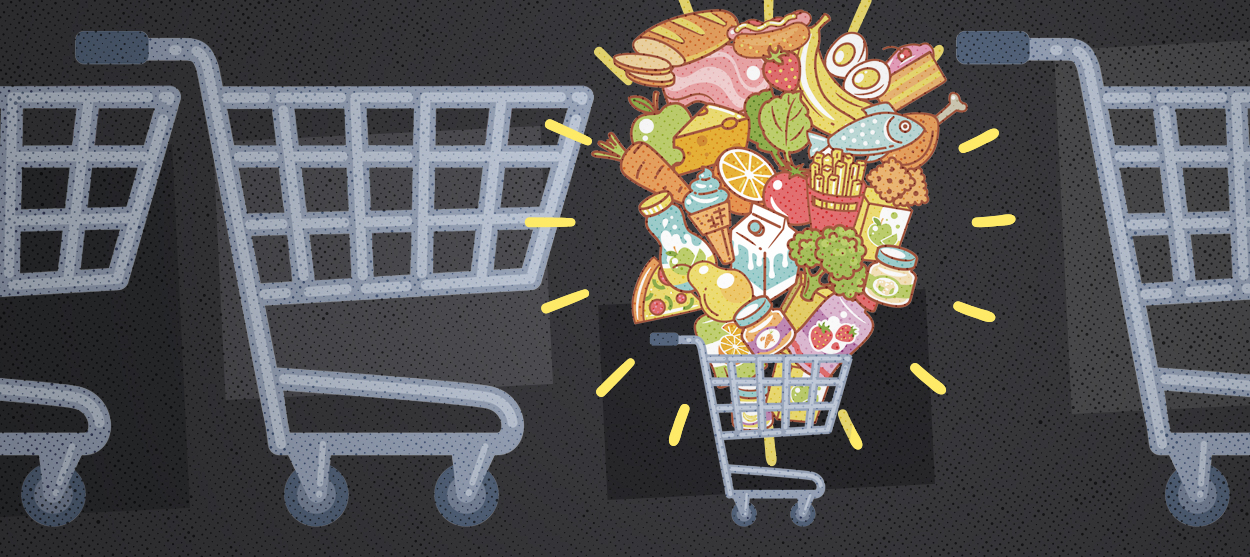The mystery of America's small groceries
Why aren't there more neighborhood markets to compete with far-away superstores?


My Twin Cities neighborhood is teeming with small, independent grocery stores. If locales without grocery access are food deserts, this is a food rainforest.
A few blocks northeast of us there's an Asian market, equipped with an abundant produce section, a butcher counter, and a boggling variety of cooking sauces. Several blocks southwest is a more traditional corner store, stocked with snacks, some basics like milk and eggs, plus beer and cigarettes. Survey the whole neighborhood — an area of less than four square miles — and there are at least 15 other small groceries, almost entirely run by Asian and North African immigrants. Several are ensconced in multi-vendor markets with a dozen or more stalls also selling household goods, clothing, and more. In warmer months, at least two host farmer's markets in their parking lots. Anywhere in my neighborhood, you can buy groceries, including affordable fresh vegetables, after walking at most half a mile.
That's not normal in America. It's not even normal for a neighborhood of this density. Outside walkable urban areas in our largest and oldest cities, the grocery landscape in the United States is dominated by supermarkets (e.g. Publix) and superstores with grocery departments (e.g. Target supercenters). (Even in walkable urban areas, these large stores have made significant inroads in recent decades.) Across income levels, the U.S. Department of Agriculture reports, about 90 percent of Americans choose these big grocers for their primary food shopping. Other retailers — a category in which the USDA included "smaller grocery stores, specialty food retailers like farmers' markets and bakeries, and other retailers, such as convenience stores, dollar stores, and drug stores" — are the primary choice for only about 5 percent.
The Week
Escape your echo chamber. Get the facts behind the news, plus analysis from multiple perspectives.

Sign up for The Week's Free Newsletters
From our morning news briefing to a weekly Good News Newsletter, get the best of The Week delivered directly to your inbox.
From our morning news briefing to a weekly Good News Newsletter, get the best of The Week delivered directly to your inbox.
But why? Americans' average grocery commute is nearly four miles, the USDA found, which is fine for households in which every adult has a car and the gas money to run it. For families without that ease of transportation, however, supermarkets aren't an obvious fit. Four miles is very different from half a mile if you're traveling by foot or bus, laden with groceries. And as poverty suburbanizes, those miles are increasingly likely to be an unpleasant walk, less city sidewalks on a navigable grid than pedestrian-unfriendly "stroads."
Wouldn't a small neighborhood grocery be better? Why isn't this apparent need being filled? If there's plausible demand, where is the supply? And if immigrant communities can make it work, why not the rest of us?
I've been thinking about this since I happened upon a Twitter discussion of it last summer. The conversation suggested three categories of explanations I wanted to explore: policy and built environment reasons (like zoning), financial reasons (like economies of scale), and cultural reasons (like what Americans want and expect from small grocery stores).
I reached out to Emily Hamilton, a senior research fellow and director of the Urbanity Project at the Mercatus Center, to talk zoning. "More so than almost any other country," she told me in an interview by email, "the U.S. approach to zoning rigidly separates land uses from each other. In other countries, neighborhood-serving retail development is permitted to be intermingled with residential development even in cities' lowest-density zones, but U.S. localities generally have single-family zones where almost all other types of development are banned, including small grocery stores and corner stores."
A free daily email with the biggest news stories of the day – and the best features from TheWeek.com
Even if zoning doesn't outright prohibit a small grocery, Hamilton said, the low population density these rules create may make it impossible for the business to turn a profit. There simply aren't enough customers nearby, and changing zoning rules "to allow for substantial increases in population density tends to be very politically difficult." The NIMBYs swarm.
While restrictive policies remain in place, Hamilton continued, chain stores "are advantaged in the development approval process [because] it's very expensive for large projects to go through many localities' permit" regime. These legal incentives mean developers prefer to build big retail spaces which small businesses can't fill and to partner with deep-pocketed chains that can reliably pay rent and costly permitting fees. (Among those chains: dollar stores, whose explosive growth and competitive pricing is driving many independent groceries out of business, frequently leaving communities without access to fresh produce, which many dollar stores don't offer.)
Zoning and permitting aren't the only obstacle in the policy category, said Daniel Herriges, an urban planner and senior editor of Strong Towns, an urbanist think tank. "A lot of the scale economies that larger stores enjoy are dependent on, or exaggerated by, the pattern of development of our cities and towns, which is in turn the outgrowth of government policy," Herriges told me.
"For example," he went on, "we build road lanes wide enough to accommodate semi-trucks [that supply superstores], and curbs at intersections are heavily rounded to accommodate their movements. This extra asphalt comes at a high direct public expense (including maintenance) and also results in environments that encourage driving and make walking dangerous and inconvenient." This stuff is difficult to notice — most of us don't spend much time thinking about the behavioral effects of road widths and intersection angles — but it can bias entire local economies in big stores' favor.
Suppose, however, we do change the zoning laws. And suppose we streamline the permitting and start building for walkability instead of huge trucks. Then would my neighborhood be less the exception and more the norm? Maybe.
Though it can serve basically the same needs, a small grocery isn't just a supermarket scaled down, especially when it must compete with actual supermarkets nearby. Jeff Wells, who is a senior editor at Grocery Dive, an industry publication, explained that there are several strategies these smaller stores can use to be financially viable.
Some "try to differentiate on service," Wells said, and he has reported on successes achieved with that approach. But many of the services Americans want now (like "curbside pickup, delivery, and app-based tools") are too resource-intensive for a small store.
A specialized inventory, like a focus on health food or a particular ethnic community, is another option (and doesn't necessarily preclude stocking basics, too). This is a key difference, Wells said in our email exchange, between the independent markets run primarily by and for immigrant communities — like those in my neighborhood — and more generic outfits. "Asian and Hispanic grocers tend to serve a more loyal customer base because they offer products and services shoppers can't find elsewhere," Wells observed. "Being the preferred store for a large, stable group of customers gives these businesses more financial flexibility" than a corner store with a selection much like a supermarket's, only far smaller and probably more expensive.
Good prices are crucial, of course — especially if a small grocery proposes to be a community's main food supply — and proximity to a dedicated customer base is vital. "You won't make a 10-mile drive to a small business with a small selection," Herriges said. "You're only likely to patronize such a business if it's conveniently located to you."
Immigrant-run businesses often achieve both affordability and proximity by "cluster[ing] in strip malls in a very defined area associated with a specific ethnic community," Herriges noted. They're able to "cut costs by leveraging a whole network of ties to suppliers and intermediaries that specifically serve" their group, he said. Delivery is more efficient and therefore cheaper when distributors can supply multiple customers in one run.
Some independent groceries in rural North Dakota are beginning to pursue a similar tactic of cooperative bulk ordering, which may save them as much as 20 percent on inventory, a huge difference in this narrow-margin industry. Clustering and cooperation like this, adapted to local needs and resources, can at least partially replicate the density of a city and the economy of scale of a superstore. It can give smaller groceries of all styles a fighting chance.
Yet the small grocery of the future may not look like the small grocery of the past. My focus on corner stores, obviously influenced by living in a neighborhood which still has them, may never be terribly helpful in lower density areas.
"That doesn't mean it's not important to expand grocery access" in these places, Herriges said, to keep them from staying or devolving into food deserts. The solution could still be small businesses, he mused, but perhaps prioritizing delivery means they'll operate out of warehouses, food trucks, or even homes ("Accessory Commercial Units") instead of storefronts. One intriguing idea I ran across: A family-run health food store in a small Minnesota town which works because it does have a storefront but doesn't have a staff. It's usually only open to co-op members, who can access the shop 24/7 with a keycard and check themselves out on a tablet.
"In the long run, it's necessary for many reasons (not just food access) to improve the walkability of the suburbs and make people less reliant on long car trips," Herriges wrote to me. "As this happens through design, regulatory, and cultural changes, demand is going to crop up for accessible neighborhood-based food options. I think we just don't know yet what physical form it will take."
Bonnie Kristian was a deputy editor and acting editor-in-chief of TheWeek.com. She is a columnist at Christianity Today and author of Untrustworthy: The Knowledge Crisis Breaking Our Brains, Polluting Our Politics, and Corrupting Christian Community (forthcoming 2022) and A Flexible Faith: Rethinking What It Means to Follow Jesus Today (2018). Her writing has also appeared at Time Magazine, CNN, USA Today, Newsweek, the Los Angeles Times, and The American Conservative, among other outlets.
-
 Cryptocurrency and the future of politics
Cryptocurrency and the future of politicsIn The Spotlight From electoral campaigns to government investments, crypto is everywhere and looks like it’s here to stay
-
 Ssh! UK libraries worth travelling for
Ssh! UK libraries worth travelling forThe Week Recommends From architectural delights to a ‘literary oasis’, these are some of the best libraries around the country
-
 A fentanyl vaccine may be on the horizon
A fentanyl vaccine may be on the horizonUnder the radar Taking a serious jab at the opioid epidemic
